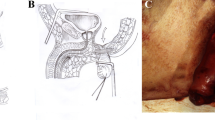Abstract.
Background:
We present new techniques of stapling anastomosis at laparoscopic colorectal surgery with retrospective review of data.
Methods:
A triangulating stapling technique (T method) was performed in 101 laparoscopic colectomies. Adouble stapling technique (DST) with rectal division by a conventional linear stapler (Abd method) was used in 5 cases of upper/middle rectal cancers and subsequent eversion of the distal rectum from the anus (Ev method) was used for 4 low rectal cancers. Four hundred ninety-six colectomies and 280 rectal surgeries were reviewed.
Results:
Leakage was lower in the T group (0.5%, n=196) than in the hand-sewn group (3.0%, n=233). Leakage of the DST using a laparoscopic linear stapler (12.1%, n=91) was significantly higher than with conventional DST (2.1%, n=189). There was no leakage with either Abd method or Ev method. The T-method is acceptable after laparoscopic colectomy.
Conclusion:
New methods of rectal division using conventional devices are expected to yield reliable anastomosis at laparoscopic rectal surgery.
Similar content being viewed by others
Author information
Authors and Affiliations
Corresponding author
Rights and permissions
About this article
Cite this article
Fukunaga, Y., Higashino, M., Tanimura, S. et al. A novel laparoscopic technique for stapled colon and rectal anastomosis. Tech Coloproctol 7, 192–197 (2003). https://doi.org/10.1007/s10151-003-0034-4
Received:
Accepted:
Published:
Issue Date:
DOI: https://doi.org/10.1007/s10151-003-0034-4




